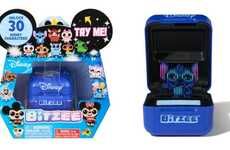
Toy Company Ganz Introduces Webkinz, the Virutal World for Kids
Bianca — April 12, 2007 — Life-Stages
References: webkinz
While adults play in virtual worlds like Second Life, kids have found a digital outlet to play too. The online gaming site is geared at tweens (ages 8-12) and owned by Canadian stuffed animal line Ganz.
The plush pets ($10-$12.50) from Ganz come with coded tags that give owners access to the Webkinz World website. When they register the ID, their pet comes to life in the virtual world.
The pet owner can then adopt the digital pet and choose its name and gender. Upon registration, the owner gets 2,000 in KinzCash to buy their pet's necessities like food and clothes. If this runs out, they can apply for jobs, like virtual burger flipping to earn more KinzCash. The e-store even has furniture so kids can customize the homes and private rooms for their virtual pals.
It's like a Tamagotchi for the big screen, but with more features. Kids can participate in trivia contests and chat with other pet owners around the world. The site has countless games which let Ganz exercise their ingenious marketing tactic: play time is restricted to certain amounts. Wheel of Wow, for example, can only be played once a day. Kids want more so they keep coming back; it also ensures they don’t get bored.
So how big is the children’s market? Packaged Facts released a report in 2005 stating that 29 million kids in the U.S. are between 8 and 14 year old. 90 per cent of them are online and have a combined purchasing power of $40 billion a year.
Virtual-reality gaming for tweens could be the next big gold mine. Ganz sold over 2 million Webkinz since April 2005. Traffic on the website is booming with over one million registered pets. The site had 1.9 million unique visitors in December, and between April 2006 and January 2007, the average user spent about 128 minutes per visit.
Webkinz is a safe place for kids to play in the virtual world and is free of advertising. The demands of kids and teens changes almost daily, making future success for virtual tween worlds a mystery. It’s a trend worth watching, however, since these are the consumers of the future.
The plush pets ($10-$12.50) from Ganz come with coded tags that give owners access to the Webkinz World website. When they register the ID, their pet comes to life in the virtual world.
The pet owner can then adopt the digital pet and choose its name and gender. Upon registration, the owner gets 2,000 in KinzCash to buy their pet's necessities like food and clothes. If this runs out, they can apply for jobs, like virtual burger flipping to earn more KinzCash. The e-store even has furniture so kids can customize the homes and private rooms for their virtual pals.
It's like a Tamagotchi for the big screen, but with more features. Kids can participate in trivia contests and chat with other pet owners around the world. The site has countless games which let Ganz exercise their ingenious marketing tactic: play time is restricted to certain amounts. Wheel of Wow, for example, can only be played once a day. Kids want more so they keep coming back; it also ensures they don’t get bored.
So how big is the children’s market? Packaged Facts released a report in 2005 stating that 29 million kids in the U.S. are between 8 and 14 year old. 90 per cent of them are online and have a combined purchasing power of $40 billion a year.
Virtual-reality gaming for tweens could be the next big gold mine. Ganz sold over 2 million Webkinz since April 2005. Traffic on the website is booming with over one million registered pets. The site had 1.9 million unique visitors in December, and between April 2006 and January 2007, the average user spent about 128 minutes per visit.
Webkinz is a safe place for kids to play in the virtual world and is free of advertising. The demands of kids and teens changes almost daily, making future success for virtual tween worlds a mystery. It’s a trend worth watching, however, since these are the consumers of the future.
Trend Themes
1. Digital Gaming for Kids - The trend of digital gaming platforms designed specifically for children presents opportunities for toy companies to create interactive and engaging experiences.
2. Virtual Reality for Tweens - The growing popularity of virtual reality gaming for tweens opens up possibilities for companies to develop innovative products and services tailored to this demographic.
3. Online Community for Young Consumers - The rise of online communities targeted at young consumers highlights the potential for companies to create safe and engaging platforms for kids to interact and play.
Industry Implications
1. Toy Industry - The toy industry can explore disruptive innovation opportunities by integrating digital gaming features and creating interactive toys that connect to online platforms.
2. Gaming Industry - The gaming industry can tap into the growing demand for virtual reality experiences among tweens by developing immersive and age-appropriate games and platforms.
3. Technology Industry - The technology industry has the potential to innovate by creating advanced virtual reality systems and online platforms that offer a safe and engaging space for young consumers.
6.7
Score
Popularity
Activity
Freshness























